曼昆(经济学原理)第五版宏观经济学
曼昆《经济学原理》(宏观)第五版测试题库(23)
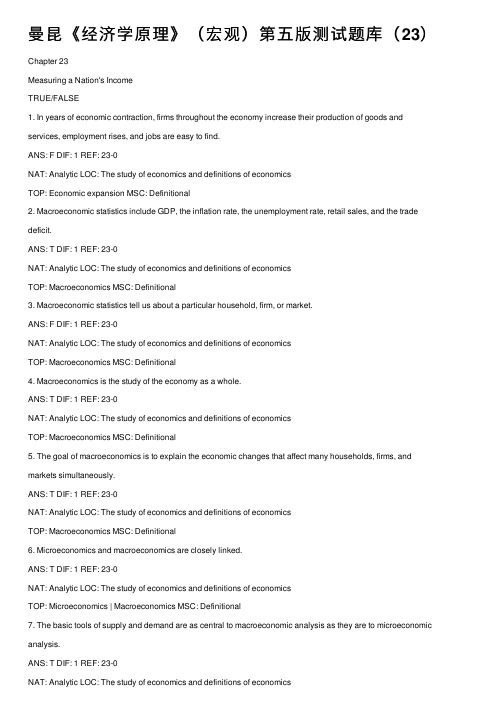
曼昆《经济学原理》(宏观)第五版测试题库(23)Chapter 23Measuring a Nation's IncomeTRUE/FALSE1. In years of economic contraction, firms throughout the economy increase their production of goods and services, employment rises, and jobs are easy to find.ANS: F DIF: 1 REF: 23-0NAT: Analytic LOC: The study of economics and definitions of economicsTOP: Economic expansion MSC: Definitional2. Macroeconomic statistics include GDP, the inflation rate, the unemployment rate, retail sales, and the trade deficit.ANS: T DIF: 1 REF: 23-0NAT: Analytic LOC: The study of economics and definitions of economicsTOP: Macroeconomics MSC: Definitional3. Macroeconomic statistics tell us about a particular household, firm, or market.ANS: F DIF: 1 REF: 23-0NAT: Analytic LOC: The study of economics and definitions of economicsTOP: Macroeconomics MSC: Definitional4. Macroeconomics is the study of the economy as a whole.ANS: T DIF: 1 REF: 23-0NAT: Analytic LOC: The study of economics and definitions of economicsTOP: Macroeconomics MSC: Definitional5. The goal of macroeconomics is to explain the economic changes that affect many households, firms, and markets simultaneously.ANS: T DIF: 1 REF: 23-0NAT: Analytic LOC: The study of economics and definitions of economicsTOP: Macroeconomics MSC: Definitional6. Microeconomics and macroeconomics are closely linked.ANS: T DIF: 1 REF: 23-0NAT: Analytic LOC: The study of economics and definitions of economicsTOP: Microeconomics | Macroeconomics MSC: Definitional7. The basic tools of supply and demand are as central to macroeconomic analysis as they are to microeconomic analysis.TOP: Demand | Supply MSC: Definitional8. GDP is the most closely watched economic statistic because it is thought to be the best single measure of asociety’s economic well-being.ANS: T DIF: 1 REF: 23-0NAT: Analytic LOC: The study of economics and definitions of economicsTOP: GDP MSC: Definitional9. GDP can measure either the total income of everyone in the economy or the total expenditure on theeconomy’s output of goods and services, but GDP cannot measure both at the same time.ANS: F DIF: 2 REF: 23-1NAT: Analytic LOC: The study of economics and definitions of economicsTOP: GDP MSC: Interpretive10. For an economy as a whole, income must exceed expenditure.ANS: F DIF: 1 REF: 23-1NAT: Analytic LOC: The study of economics and definitions of economics11. An economy’s income is the same as its expenditure because every transaction has a buyer and a seller. ANS: T DIF: 1 REF: 23-1NAT: Analytic LOC: The study of economics and definitions of economicsTOP: Income | Expenditure MSC: Definitional12. GDP is the market value of all final goods and services produced by a country’s citizens in a given period oftime.ANS: F DIF: 1 REF: 23-2NAT: Analytic LOC: The study of economics and definitions of economicsTOP: GDP MSC: Definitional13. GDP adds together many different kinds of products into a single measure of the value of economic activity byusing market prices.ANS: T DIF: 1 REF: 23-2NAT: Analytic LOC: The study of economics and definitions of economicsTOP: GDP MSC: Definitional14. U.S. GDP includes the market value of rental housing, but not the market value of owner-occupied housing. ANS: F DIF: 2 REF: 23-2NAT: Analytic LOC: The study of economics and definitions of economicsTOP: GDP MSC: Interpretive15. U.S. GDP excludes the production of most illegal goods.ANS: T DIF: 2 REF: 23-2NAT: Analytic LOC: The study of economics and definitions of economics16. U.S. GDP includes estimates of the value of items that are produced and consumed at home, such as housework and car maintenance.ANS: F DIF: 2 REF: 23-2NAT: Analytic LOC: The study of economics and definitions of economicsTOP: GDP MSC: Applicative17. GDP includes only the value of final goods because the value of intermediate goods is already included in the prices of the final goods.ANS: T DIF: 1 REF: 23-2NAT: Analytic LOC: The study of economics and definitions of economicsTOP: GDP | Intermediate goods MSC: Definitional18. Additions to inventory subtract from GDP, and when the goods in inventory are later used or sold, the reductions in inventory add to GDP.ANS: F DIF: 1 REF: 23-2NAT: Analytic LOC: The study of economics and definitions of economicsTOP: GDP | Inventory MSC: Definitional19. While GDP includes tangible goods such as books and bug spray, it excludes intangible services such as the services provided by teachers and exterminators.ANS: F DIF: 2 REF: 23-2NAT: Analytic LOC: The study of economics and definitions of economicsTOP: GDP MSC: Applicative20. At a rummage sale, you buy two old books and an old rocking chair; your spending on these items is not included in current GDP.ANS: T DIF: 2 REF: 23-2NAT: Analytic LOC: The study of economics and definitions of economicsTOP: GDP MSC: Applicative21. When an American doctor opens a practice in Bermuda, his production there is part of U.S. GDP.ANS: F DIF: 2 REF: 23-2NAT: Analytic LOC: The study of economics and definitions of economics1560 Chapter 23 /Measuring a Nation's Income22. If the U.S. government reports that GDP in the third quarter was $12 trillion at an annual rate, then the amount of income and expenditure during quarter three was $3 trillion.ANS: T DIF: 2 REF: 23-2NAT: Analytic LOC: The study of economics and definitions of economicsTOP: GDP MSC: Applicativedifferent stories about overall economic conditions.ANS: F DIF: 2 REF: 23-2NAT: Analytic LOC: The study of economics and definitions of economicsTOP: GDP | Income MSC: Interpretive24. Expenditures by households on education are included in the consumption component of GDP.ANS: T DIF: 2 REF: 23-3NAT: Analytic LOC: The study of economics and definitions of economicsTOP: Consumption MSC: Interpretive25. Most goods whose purchases are included in the investment component of GDP are used to produce other goods.ANS: T DIF: 2 REF: 23-3NAT: Analytic LOC: The study of economics and definitions of economicsTOP: Investment MSC: Interpretive26. New home construction is included in the consumption component of GDP.ANS: F DIF: 2 REF: 23-3NAT: Analytic LOC: The study of economics and definitions of economicsTOP: Investment MSC: Interpretive27. Changes in inventory are included in the investment component of GDP.ANS: T DIF: 2 REF: 23-3NAT: Analytic LOC: The study of economics and definitions of economicsTOP: Investment MSC: Interpretive28. The investment component of GDP refers to financial investment in stocks and bonds.ANS: F DIF: 2 REF: 23-3NAT: Analytic LOC: The study of economics and definitions of economicsTOP: Investment MSC: Interpretive29. The government purchases component of GDP includes salaries paid to soldiers but not Social Security benefits paid to the elderly.ANS: T DIF: 2 REF: 23-3NAT: Analytic LOC: The study of economics and definitions of economicsTOP: Government purchases MSC: Interpretive30. If the value of an economy’s imports exceeds the value of that economy’s exports, then net exports is a negative number.ANS: T DIF: 2 REF: 23-3NAT: Analytic LOC: The study of economics and definitions of economics31. If someone in the United States buys a surfboard produced in Australia, then that purchase is included in both the consumption component of U.S. GDP and the net exports component of U.S. GDP.ANS: T DIF: 2 REF: 23-3NAT: Analytic LOC: The study of economics and definitions of economicsTOP: Consumption | Net exports MSC: Applicative32. If consumption is $4000, exports are $300, government purchases are $1000, imports are $400, and investment is $800, then GDP is $5700.ANS: T DIF: 2 REF: 23-3NAT: Analytic LOC: The study of economics and definitions of economics33. If exports are $500, GDP is $8000, government purchases are $1200, imports are $700, and investment is $800, then consumption is $6200.ANS: T DIF: 2 REF: 23-3NAT: Analytic LOC: The study of economics and definitions of economicsTOP: Consumption MSC: Applicative34. If consumption is $1800, GDP is $4300, government purchases are $1000, imports are $700, and investment i s $1200, then exports are $300.ANS: F DIF: 2 REF: 23-3NAT: Analytic LOC: The study of economics and definitions of economicsTOP: Exports MSC: Applicative35. U.S. GDP was almost $14 billion in 2007.ANS: F DIF: 1 REF: 23-3NAT: Analytic LOC: The study of economics and definitions of economicsTOP: GDP MSC: Definitional36. In 2007, government purchases was the largest component of U.S. GDP.ANS: F DIF: 2 REF: 23-3NAT: Analytic LOC: The study of economics and definitions of economicsTOP: GDP MSC: Interpretive37. If total spending rises from one year to the next, then the economy must be producing a larger output of goods and services.ANS: F DIF: 2 REF: 23-4NAT: Analytic LOC: The study of economics and definitions of economicsTOP: GDP MSC: Interpretive38. An increase in nominal U.S. GDP necessarily implies that the United States is producing a larger output of goods and services.TOP: Nominal GDP MSC: Interpretive39. Nominal GDP uses constant base-year prices to place a value on the economy’s production of goods a nd services, while real GDP uses current prices to place a value on the economy’s production of goods and services.ANS: F DIF: 1 REF: 23-4NAT: Analytic LOC: The study of economics and definitions of economicsTOP: Nominal GDP | Real GDP MSC: Definitional40. Real GDP evaluates current production using prices that are fixed at past levels and therefore shows how the economy’s overall production of goods and services changes over time.ANS: T DIF: 1 REF: 23-4NAT: Analytic LOC: The study of economics and definitions of economicsTOP: Real GDP MSC: Definitional41. The term real GDP refers to a country’s actual GDP as opposed to its estimated GDP.ANS: F DIF: 2 REF: 23-4NAT: Analytic LOC: The study of economics and definitions of economicsTOP: Real GDP MSC: Interpretive42. Changes in real GDP reflect only changes in the amounts being produced.ANS: T DIF: 1 REF: 23-4NAT: Analytic LOC: The study of economics and definitions of economicsTOP: Real GDP MSC: Definitional43. Real GDP is a better gauge of economic well-being than is nominal GDP.ANS: T DIF: 1 REF: 23-4NAT: Analytic LOC: The study of economics and definitions of economics1562 Chapter 23 /Measuring a Nation's Income44. Changes in the GDP deflator reflect only changes in the prices of goods and services.ANS: T DIF: 2 REF: 23-4NAT: Analytic LOC: The study of economics and definitions of economicsTOP: GDP deflator MSC: Interpretive45. If nominal GDP is $10,000 and real GDP is $8,000, then the GDP deflator is 125.ANS: T DIF: 2 REF: 23-4NAT: Analytic LOC: The study of economics and definitions of economicsTOP: GDP deflator MSC: Applicative46. If nominal GDP is $12,000 and the GDP deflator is 80, then real GDP is $15,000.TOP: Real GDP MSC: Applicative47. Economists use the term inflation to describe a situation in whic h the economy’s overall production level isrising.ANS: F DIF: 1 REF: 23-4NAT: Analytic LOC: Unemployment and inflation TOP: InflationMSC: Definitional48. If the GDP deflator in 2006 was 160 and the GDP deflator in 2007 was 180, then the inflation rate in 2007 was12.5%.ANS: T DIF: 2 REF: 23-4NAT: Analytic LOC: Unemployment and inflation TOP: Inflation rateMSC: Applicative49. If the GDP deflator in 2004 was 150 and the GDP deflator in 2005 was 120, then the inflation rate in 2005 was25%.ANS: F DIF: 2 REF: 23-4NAT: Analytic LOC: Unemployment and inflation TOP: Inflation rateMSC: Applicative50. The GDP deflator can be used to take inflation out of nominal GDP.ANS: T DIF: 1 REF: 23-4NAT: Analytic LOC: The study of economics and definitions of economicsTOP: GDP deflator MSC: Definitional51. In 2004, the level of U.S. real GDP was close to four times its 1965 l evel.ANS: T DIF: 1 REF: 23-4NAT: Analytic LOC: The study of economics and definitions of economicsTOP: Real GDP MSC: Definitional52. The output of goods and services produced in the United States has grown on average 3.2 percent per year. ANS: T DIF: 1 REF: 23-4NAT: Analytic LOC: Productivity and growthTOP: GrowthMSC: Definitional53. Periods during which real GDP rises are called recessions.ANS: F DIF: 1 REF: 23-4NAT: Analytic LOC: The study of economics and definitions of economicsTOP: Recessions MSC: Definitional54. Recessions are associated with lower incomes, rising unemployment, and falling profits.TOP: Recessions MSC: Definitional55. If real GDP is higher in one country than in another, then we can be sure that the standard of living is higher inthe country with the higher real GDP.ANS: F DIF: 2 REF: 23-5NAT: Analytic LOC: The study of economics and definitions of economicsTOP: Real GDP | Standard of living MSC: Interpretive56. Real GDP per person tells us the income and expenditure of the average person in the economy.ANS: T DIF: 1 REF: 23-5NAT: Analytic LOC: The study of economics and definitions of economicsTOP: Real GDP per person MSC: Definitional57. GDP does not directly measure those things that make life worthwhile, but it does measure our ability toobtain many of the inputs into a worthwhile life.ANS: T DIF: 1 REF: 23-5NAT: Analytic LOC: The study of economics and definitions of economicsTOP: GDP MSC: Definitional58. GDP does not make adjustments for leisure time, environmental quality, or volunteer work.ANS: T DIF: 2 REF: 23-5NAT: Analytic LOC: The study of economics and definitions of economicsTOP: GDP MSC: Interpretive59. Other things equal, in countries with higher levels of real GDP per person, life expectancy and literacy ratesare higher than in countries with lower levels of real GDP per person.ANS: T DIF: 2 REF: 23-5NAT: Analytic LOC: The study of economics and definitions of economicsTOP: GDP MSC: InterpretiveSHORT ANSWER1. GDP is defined as the market value of all final goods and services produced within a country in a given periodof time. In spite of this definition, some production is left out of GDP. Explain why some final goods and services are not included.ANS:GDP excludes some products because they are so difficult to measure. These products include services performed by individuals for themselves and their families, and most goods that are produced and consumed at home and, therefore, never enter the marketplace. In addition, illegal products are not included in GDP even if they can be measured because, by society's definition, they are bads, not goods.DIF: 2 REF: 23-2 NAT: AnalyticLOC: The study of economics and definitions of economics TOP: GDPMSC: Interpretiveincluded directly as part of GDP, but the value of intermediate goods produced and not sold is includeddirectly as part of GDP.ANS:Intermediate goods produced and sold during the year are not included separately as part of GDP because the value of those goods is included in the value of the final goods produced from them. If the intermediate good is produced but not sold during the year, its value is included as inventory investment for the year in which it was produced. If inventory investment was not included as part of GDP, true production would be underestimated for the year the intermediate good went into inventory, and overestimated for the year the intermediate good is used or sold.DIF: 2 REF: 23-2 NAT: AnalyticLOC: The study of economics and definitions of economics TOP: GDP | Intermediate goods MSC: Interpretive1564 Chapter 23 /Measuring a Nation's Income3. Since it is counted as investment, why doesn't the purchase of earthmoving equipment from China by a U.S.corporation increase U.S. GDP?ANS:The purchase of foreign equipment is counted as investment, but GDP measures only the value of production within the geographic borders of the United States. In order to avoid including the value of the imported equipment, imports are subtracted from GDP. Hence, the value of the equipment in investment is canceled by subtracting its value as an import.DIF: 2 REF: 23-3 NAT: AnalyticLOC: The study of economics and definitions of economics TOP: GDP | Investment | Imports MSC: Applicative4. Identify the immediate effect of each of the following events on U.S. GDP and its components.a. James receives a Social Security check.b. John buys an Italian sports car.c. Henry buys domestically produced tools for his construction company.ANS:a. Since this is a transfer payment, there is no change to GDP or to any of its components.b. Consumption and imports will rise and cancel each other out so that there is no change in U.S. G DP.c. This increases the investment component of GDP and so increases GDP.DIF: 2 REF: 23-3 NAT: AnalyticLOC: The study of economics and definitions of economicsTOP: GDP | Transfer payments | Net exports | Investment MSC: Applicative5. Between 1929 and 1933, NNP measured in current prices fell from $96 billion to $48 billion. Over the sameperiod, the relevant price index fell from 100 to 75.a. What was the percentage decline in nominal NNP from 1929 to1933?b. What was the percentage decline in real NNP from 1929 to 1933? Show your work.ANS:a. NNP measured in current prices is nominal NNP. Nominal NNP fell from $96 billion to $48 billion, adecline of 50 percent.($96 b/100) 100 = $96 b. Real NNP in 1933 was ($48 b/75) 100 = $64 b. Real NNP fell from$96 billion to $64 billion, a decline of 33 percent.DIF: 2 REF: 23-4 NAT: AnalyticLOC: The study of economics and definitions of economics TOP: Nominal NNP | Real NNP MSC: Applicative6. You find that your paycheck for the year is higher this year than last. Does that mean that your real incomehas increased? Explain carefully.ANS:Real income is nominal income adjusted for general increase in prices. I f my paycheck is higher this year than last, my nominal income has increased. Whether my real income has increased or not depends on what has happened since last year to the level of prices of things I buy with my income. If the percentage increase in prices is less than the percentage increase in my nominal income, then my real income h as increased. Otherwise, my real income has not increased.DIF: 2 REF: 23-4 NAT: AnalyticLOC: The study of economics and definitions of economicsTOP: Nominal income | Real income MSC: Interpretive7. U.S. real GDP is substantially higher today than it was 60 years ago. What does this tell us, and what does itnot tell us, about the well-being of U.S. residents?ANS:Since this is in real terms, it tells us that the U.S. is able to make a lot more stuff than in the past. Some of the increase in real GDP is probably due to an increase in population, so we could say more if we knew what had happened to real GDP per person. Supposing that there was also an increase in real GDP per person, we can say that the standard of living has risen. Material things are an important part of well-being. Having sufficient amounts of things such as food, shelter, and clothing are fundamental to well-being. Other things such as security, a safe environment, access to safe water, access to medical care, justice, and freedom also matter. However, many of these things are more easily obtained by being able to produce more using fewer resources. Countries with higher real GDP per person tend to have longer life spans, less discrimination towards women, less child labor, and a higher rate of literacy.DIF: 2 REF: 23-5 NAT: AnalyticLOC: The study of economics and definitions of economicsTOP: Real GDP | Economic welfare MSC: InterpretiveSec00 - Measuring a Nation's IncomeMULTIPLE CHOICE1. Statistics that are of particular interest to macroeconomistsa. are largely ignored by the media.b. are widely reported by the media.c. include the equilibrium prices of individual goods and services.d. tell us about a particular household, firm, or market.ANS: B DIF: 2 REF: 23-0NAT: Analytic LOC: The study of economics and definitions of economicsTOP: Macroeconomics MSC: Interpretiveb. the interaction between households and firms.c. economy-wide phenomena.d. regulations on firms and unions.ANS: C DIF: 1 REF: 23-0NAT: Analytic LOC: The study of economics and definitions of economicsTOP: Macroeconomics MSC: Definitional3. Which of the following newspaper headlines is more closely related to what microeconomists study than to what macroeconomists study?a. Unemployment rate rises from 5 percent to 5.5 percent.b. Real GDP grows by 3.1 percent in the third quarter.c. Retail sales at stores show large gains.d. The price of oranges rises after an early frost.ANS: D DIF: 2 REF: 23-0NAT: Analytic LOC: The study of economics and definitions of economicsTOP: Microeconomics | Macroeconomics MSC: Interpretive4. Which of the following questions is more likely to be studied by a microeconomist than a macroeconomist?a. Why do prices in general rise by more in some countries than in others?b. Why do wages differ across industries?c. Why do production and income increase in some periods and not in others?d. How rapidly is GDP currently increasing?ANS: B DIF: 2 REF: 23-0NAT: Analytic LOC: The study of economics and definitions of economicsTOP: Microeconomics | Macroeconomics MSC: Interpretive1566 Chapter 23 /Measuring a Nation's Income5. Which of the following topics are more likely to be studied by a macroeconomist than by a microeconomist?a. the effect of taxes on the prices of airline tickets, the profitability of automobile-manufacturingfirms, and employment trends in the food-service industryb. the price of beef, wage differences between genders, and antitrust lawsc. how consumers maximize utility, and how prices are established in markets for agriculturalproductsd. the percentage of the labor force that is out of work, and differences in average income fromcountry to countryANS: D DIF: 2 REF: 23-0NAT: Analytic LOC: The study of economics and definitions of economicsTOP: Microeconomics | Macroeconomics MSC: Interpretive6. We would expect a macroeconomist, as opposed to a microeconomist, to be particularly interested ina. explaining how economic changes affect prices of particular goods.b. devising policies to deal with market failures such as externalities and market power.c. devising policies to promote low inflation.d. identifying those markets that are competitive and those that are not competitive.ANS: C DIF: 2 REF: 23-0NAT: Analytic LOC: The study of economics and definitions of economicsTOP: Microeconomics | Macroeconomics MSC: Interpretive7. Which of the following is not a question that macroeconomists address?a. Why is average income high in some countries while it is low in others?b. Why does the price of oil rise when war erupts in the Middle East?c. Why do production and employment expand in some years and contract in others?d. Why do prices rise rapidly in some periods of time while they are more stable in other periods? ANS: B DIF: 2 REF: 23-0 NAT: Analytic LOC: The study of economics and definitions of economicsTOP: Macroeconomics MSC: Interpretive8. The basic tools of supply and demand area. useful only in the analysis of economic behavior in individual markets.b. useful in analyzing the overall economy, but not in analyzing individual markets.c. central to microeconomic analysis, but seldom used in macroeconomic analysis.d. central to macroeconomic analysis as well as to microeconomic analysis.ANS: D DIF: 1 REF: 23-0NAT: Analytic LOC: The study of economics and definitions of economicsTOP: Demand | Supply MSC: Definitional9. Which of the following statistic is usually regarded as the best single measure of a society’s economic well-being?a. the unemployment rateb. the inflation ratec. gross domestic productd. the trade deficitANS: C DIF: 1 REF: 23-0NAT: Analytic LOC: The study of economics and definitions of economicsTOP: GDP MSC: DefinitionalSec01 - Measuring a Nation's Income - The Economy's Income and Expenditure MULTIPLE CHOICE1. Which of the following statements about GDP is correct?a. GDP measures two things at once: the total income of everyone in the economy and the unemployment rate of the economy’s labor force.b. Money continuously flows from households to government and then back to households, and GDP measures this flow of money.c. GDP is to a nation’s economy as household income is to a household.d. All of the above are correct.ANS: C DIF: 2 REF: 23-1NAT: Analytic LOC: The study of economics and definitions of economicsTOP: GDP MSC: Interpretive2. Gross domestic product measures two things at once:a. the total spending of everyone in the economy and the total saving of everyone in the economy.b. the total income of everyone in the economy and the total expenditure on the economy's output of goods and services.c. the value of the economy's output of goods and services for domestic citizens and the value of the economy's output of goods and services for the rest of the world.d. the total income of households in the economy and the total profit of firms in the economy. ANS: B DIF: 1 REF: 23-1NAT: Analytic LOC: The study of economics and definitions of economicsTOP: GDP MSC: Definitional3. For an economy as a whole,a. wages must equal profit.b. consumption must equal saving.c. income must equal expenditure.d. the number of buyers must equal the number of sellers.ANS: C DIF: 2 REF: 23-1NAT: Analytic LOC: The study of economics and definitions of economicsTOP: Income | Expenditure MSC: Interpretive4. For an economy as a whole, income must equal expenditure becausea. the number of firms is equal to the number of households in an economy.b. international law requires that income equal expenditure.c. every dollar of spending by some buyer is a dollar of income for some seller.d. every dollar of saving by some consumer is a dollar of spending by some other consumer. ANS: C DIF: 2 REF: 23-1NAT: Analytic LOC: The study of economics and definitions of economicsTOP: Income | Expenditure MSC: Interpretive5. If an economy’s GDP rises, then it must be the case that the economy’sa. income rises and saving falls.b. income and saving both rise.c. income rises and expenditure falls.d. income and expenditure both rise.ANS: D DIF: 2 REF: 23-1NAT: Analytic LOC: The study of economics and definitions of economics TOP: Income | Expenditure MSC: Interpretive。
曼昆宏观经济学原理第五版chap33to35课后习题答案(中文)

答:这种“为了安全的资本外逃”对美国经济是件好事。
当外国人增加了对美国政府债券的需求时,这种行动减少了美国的资本净流出。
国外净投资减少时,美国可贷资金市场上的可贷资金需求减少,可贷资金的需求减少使利率下降,利率下降增加了国内投资,减少了国民储蓄。
资本净流出减少使得美国外汇市场上的美元供给减少,外汇市场上美元供给的减少引起实际汇率上升,实际汇率上升使贸易余额倾向于赤字。
13.假设美国共同基金突然决定更多地在加拿大投资。
A.加拿大的资本净流出、储蓄和国内投资会发生什么变动?答:加拿大的资本净流出会下降,加拿大的国内投资会增加,储蓄会下降。
B.这对加拿大资本存量的长期影响是什么?答:这会增加加拿大的长期资本存量。
C.资本存量的这种变化将如何影响加拿大劳动市场?这种美国在加拿大的投资使加拿大工人状况变好还是变坏?答:资本存量的这种变化会增加加拿大劳动市场的劳动需求。
这种美国在加拿大的投资使加拿大工人状况变好。
D.你认为这将使美国工人状况变好还是变坏?你能想到有什么原因一般会使这对美国公民的影响与对美国工人的影响不同?答:这将使美国工人状况变坏。
因为美国共同基金增加在加拿大的投资增加了美国公民的投资利润,但由于国内投资下降,美国工人的情况变坏。
第十二篇短期经济波动第三十三章总需求与总供给复习题1.写出当经济进入衰退时下降的两个宏观经济变量。
写出当经济进入衰退时上升的一个宏观经济变量。
答:当经济进入衰退时,实际GDP和投资支出下降,失业率上升。
2.画出一个有总需求、短期总供给和长期总供给的曲线的图。
仔细并正确地标出坐标轴。
答:图33—1经济的长期均衡3.列出并解释总需求曲线向右下方倾斜的三个原因。
答:为了理解总需求曲线向右下方倾斜的原因,我们必须考察物价水平如何影响消费、投资和净出口的物品与劳务需求量。
(1)庇古的财富效应:物价水平下降使消费者感到更富裕,这又鼓励他们更多地支出,消费支出增加意味着物品与劳务的需求量更大。
曼昆《经济学原理》宏观经济学ppt课件

研究对象
宏观经济学主要关注整个经济体系的总体运行,包 括总需求、总供给、国民收入、物价水平、就业和 经济增长等。
宏观经济学与微观经济学的关系
相互联系
宏观经济学和微观经济学是经济学的两个重要分支,它们之间相互联系、相互补充。 微观经济学是宏观经济学的基础,而宏观经济学则是微观经济学的延伸和扩展。
区别
开放经济下的政策目标
货币政策与财政政策
实现内外部经济均衡,即国内经济增长、充 分就业、物价稳定和国际收支平衡。
在开放经济下,政府可以运用货币政策和财 政政策来调节经济,但需要考虑汇率和国际 收支等因素。
汇率政策
国际经济政策协调
政府可以通过调整汇率水平来影响国际经济 活动和国内经济状况。
各国政府需要加强国际经济政策协调,共同 应对全球性经济问题,促进世界经济稳定发 展。
支持通货膨胀
凯恩斯主义宏观经济学派认为,适度的通货膨胀可以刺激 经济增长,政府可以通过控制货币供应量等手段来调节通 货膨胀率。
货币主义宏观经济学派
强调货币供应量
货币主义宏观经济学派认为,货币供应量的变化是影响经济波动 的主要因素,政府应该通过控制货币供应量来调节经济。
主张单一规则
该学派主张政府应该制定一个固定的货币增长规则,并严格执行, 以保持物价的稳定和经济的增长。
VS
政策效应互补
货币政策和财政政策在调控经济时具有不 同的特点和优势,可以相互补充、协调配 合,提高宏观调控效果。例如,在治理通 货膨胀时,可以采取紧缩性货币政策和扩 张性财政政策相配合的方式;在促进经济 增长时,可以采取扩张性货币政策和紧缩 性财政政策相配合的方式。
05
国际经济学与宏观经济政策
Chapter
曼昆宏观经济学原理第五版chap31to32课后习题答案(中文)

未预期的通货膨胀降低了政府债券的投资价值。
11.解释一种与未预期到的通货膨胀相关而与预期到的通货膨胀无关的害处。
然后解释一种既与预期到的通货膨胀相关,又与未预期到的通货膨胀相关的害处。
答:未预期到的通货膨胀会以一种既与才能无关又与需要无关的方式在人们中重新分配财富,这种再分配的发生最可能发生在以固定价格来计量的贷款中。
它会以损害债权人的代价而减轻债务人的偿还负担。
无论通货膨胀是否预期到了,它都会扭曲价格信号、影响货币的正常使用,使现金的名义利率从零变为负数。
12.说明以下陈述正确、错误,还是不确定。
A.“通货膨胀伤害了债务人的利益而帮助了债权人,因为债务人必须支付更高的利率。
”答:这种陈述不确定。
如果实际通货膨胀率高于预期通货膨胀率,则帮助了债务人,因为实际利率低于预期名义利率。
如果实际通货膨胀率低于预期通货膨胀率,则帮助了债权人,因为实际利率高于预期名义利率。
B.“如果价格以一种使物价总水平不变的方式变动,那么,没有一个人的状况会变得更好或更坏。
”答一:这种陈述正确。
答二:这种陈述错误。
因为即使物价总水平保持不变,但相对价格的变动也会使一些人的福利变好,而使另一些人的福利变坏。
C.“通货膨胀并没有降低大多数工人的购买力。
”答一:这种陈述错误。
因为通货膨胀降低了大多数工人的购买力。
大多数工人的工资由于长期劳资合约的限制不能迅速调整,因此工人的工资增长慢于通货膨胀的攀升。
答二:这种陈述正确。
因为大多数工人的工资根据通货膨胀率的变动而进行合理的调整。
第十一篇开放经济宏观经济学第三十一章开放经济宏观经济学:基本概念复习题1.定义净出口与资本净流出。
解释它们如何相关以及为什么相关。
答:净出口是一国的出口值减去进口值,又称贸易余额。
资本净流出是指本国居民购买的外国资产减去外国人购买的国内资产。
一个开放经济以两种方式与世界其他经济相互交易——在世界物品与劳务市场上和世界金融市场上。
净出口和资本净流出分别衡量了这些市场上的不平衡类型。
2024年度-曼昆经济学原理第五宏观经济学学习教案

曼昆经济学原理第五宏观经济学学习教案CATALOGUE 目录•宏观经济学概述•国民收入核算与经济增长•失业、通货膨胀与货币政策•总供给与总需求模型•国际经济学基础•当代宏观经济问题与挑战01宏观经济学概述宏观经济学的定义与研究对象定义宏观经济学是研究整个经济体系的总体经济行为、经济表现及其内在规律的一门学科。
研究对象宏观经济学主要关注整个经济体系的总体问题,如总产出、总就业、总价格水平、经济增长、经济周期波动等。
宏观经济学与微观经济学的关系联系宏观经济学和微观经济学都是经济学的重要分支,两者相互补充,共同构成了完整的经济学体系。
微观经济学是宏观经济学的基础,宏观经济学则需要在微观经济学的基础上进行研究。
区别微观经济学研究个体经济单位(如家庭、企业等)的经济行为,而宏观经济学则研究整个经济体系的总体问题。
此外,两者的研究方法、研究目的和研究重点也有所不同。
通过收集和分析大量经济数据,运用统计和计量经济学等方法,对经济现象进行描述、解释和预测。
实证分析方法以一定的价值判断为基础,提出分析处理经济问题的标准,并以此作为制定经济政策的依据。
规范分析方法通过对历史数据的分析和比较,揭示经济现象的本质和规律,为现实经济问题的解决提供借鉴。
历史分析方法从制度角度出发,分析制度对经济行为和经济表现的影响,以及如何通过制度改革促进经济发展。
制度分析方法宏观经济学的研究方法02国民收入核算与经济增长国民收入核算体系国内生产总值(GDP)的核算方法包括生产法、收入法和支出法,用于衡量一国或地区在一定时期内生产的所有最终产品和服务的市场价值总和。
国民生产总值(GNP)的核算方法与国内生产总值相似,但包括本国公民在外国生产的最终产品和服务的市场价值。
国民收入(NI)的核算方法指一国或地区在一定时期内所有居民通过劳动、资本和土地等生产要素所获得的收入总和,包括工资、利息、租金和利润等。
经济增长的衡量与影响因素经济增长率的计算通常使用国内生产总值或国民生产总值的增长率来衡量经济增长,计算公式为(本期值-上期值)/上期值*100%。
经济学原理第五版中文曼昆 名词解释
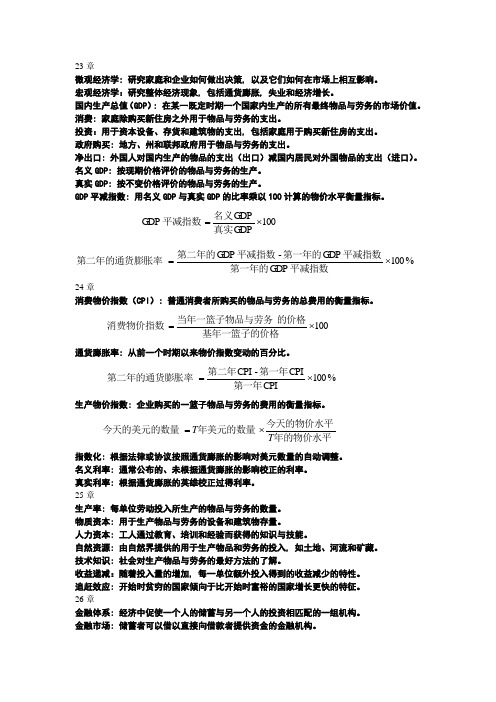
23章微观经济学: 研究家庭和企业如何做出决策, 以及它们如何在市场上相互影响。
宏观经济学:研究整体经济现象, 包括通货膨胀, 失业和经济增长。
国内生产总值(GDP ): 在某一既定时期一个国家内生产的所有最终物品与劳务的市场价值。
消费: 家庭除购买新住房之外用于物品与劳务的支出。
投资:用于资本设备、存货和建筑物的支出, 包括家庭用于购买新住房的支出。
政府购买: 地方、州和联邦政府用于物品与劳务的支出。
净出口: 外国人对国内生产的物品的支出(出口)减国内居民对外国物品的支出(进口)。
名义GDP: 按现期价格评价的物品与劳务的生产。
真实GDP: 按不变价格评价的物品与劳务的生产。
GDP 平减指数: 用名义GDP 与真实GDP 的比率乘以100计算的物价水平衡量指标。
100G DPG DP G DP ⨯=真实名义平减指数 %100G DP G DP -G DP ⨯=平减指数第一年的平减指数第一年的平减指数第二年的第二年的通货膨胀率 24章消费物价指数(CPI ): 普通消费者所购买的物品与劳务的总费用的衡量指标。
100⨯=基年一篮子的价格的价格当年一篮子物品与劳务消费物价指数 通货膨胀率: 从前一个时期以来物价指数变动的百分比。
%100CPICPI -CPI ⨯=第一年第一年第二年第二年的通货膨胀率 生产物价指数: 企业购买的一篮子物品与劳务的费用的衡量指标。
年的物价水平今天的物价水平年美元的数量今天的美元的数量T T ⨯= 指数化: 根据法律或协议按照通货膨胀的影响对美元数量的自动调整。
名义利率: 通常公布的、未根据通货膨胀的影响校正的利率。
真实利率: 根据通货膨胀的英雄校正过得利率。
25章生产率: 每单位劳动投入所生产的物品与劳务的数量。
物质资本: 用于生产物品与劳务的设备和建筑物存量。
人力资本: 工人通过教育、培训和经验而获得的知识与技能。
自然资源: 由自然界提供的用于生产物品和劳务的投入, 如土地、河流和矿藏。
曼昆《经济学原理》(宏观)第五版测试题库(30)
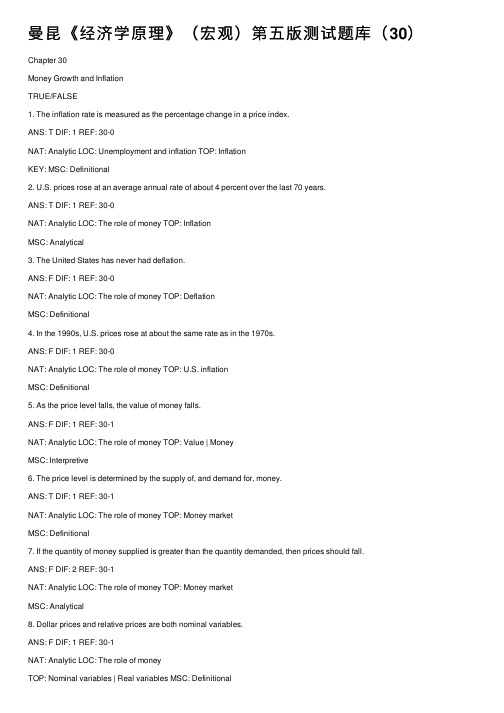
曼昆《经济学原理》(宏观)第五版测试题库(30)Chapter 30Money Growth and InflationTRUE/FALSE1. The inflation rate is measured as the percentage change in a price index.ANS: T DIF: 1 REF: 30-0NAT: Analytic LOC: Unemployment and inflation TOP: InflationKEY: MSC: Definitional2. U.S. prices rose at an average annual rate of about 4 percent over the last 70 years.ANS: T DIF: 1 REF: 30-0NAT: Analytic LOC: The role of money TOP: InflationMSC: Analytical3. The United States has never had deflation.ANS: F DIF: 1 REF: 30-0NAT: Analytic LOC: The role of money TOP: DeflationMSC: Definitional4. In the 1990s, U.S. prices rose at about the same rate as in the 1970s.ANS: F DIF: 1 REF: 30-0NAT: Analytic LOC: The role of money TOP: U.S. inflationMSC: Definitional5. As the price level falls, the value of money falls.ANS: F DIF: 1 REF: 30-1NAT: Analytic LOC: The role of money TOP: Value | MoneyMSC: Interpretive6. The price level is determined by the supply of, and demand for, money.ANS: T DIF: 1 REF: 30-1NAT: Analytic LOC: The role of money TOP: Money marketMSC: Definitional7. If the quantity of money supplied is greater than the quantity demanded, then prices should fall.ANS: F DIF: 2 REF: 30-1NAT: Analytic LOC: The role of money TOP: Money marketMSC: Analytical8. Dollar prices and relative prices are both nominal variables.ANS: F DIF: 1 REF: 30-1NAT: Analytic LOC: The role of moneyTOP: Nominal variables | Real variables MSC: Definitional9. The quantity equation is M x V = P x Y.ANS: T DIF: 1 REF: 30-1NAT: Analytic LOC: The role of money TOP: Quantity equationMSC: Definitional10. According to the Fisher effect, if inflation rises then the nominal interest rate rises.ANS: T DIF: 1 REF: 30-1NAT: Analytic LOC: The role of money TOP: Fisher effectMSC: Definitional11. An increase in money demand would create a surplus of money at the original value of money.ANS: F DIF: 2 REF: 30-1NAT: Analytic LOC: The role of money TOP: Money marketMSC: Applicative201412. Hyperinflations are associated with governments printing money to finance expenditures.ANS: T DIF: 1 REF: 30-1NAT: Analytic LOC: Unemployment and inflation TOP: HyperinflationMSC: Definitional13. For a given level of money and real GDP, an increase in velocity would lead to an increase in the price level. ANS: T DIF: 2 REF: 30-1NAT: Analytic LOC: The role of money TOP: Velocity of moneyMSC: Analytical14. The quantity theory of money can explain hyperinflations but not moderate i nflation.ANS: F DIF: 1 REF: 30-1NAT: Analytic LOC: The role of money TOP: HyperinflationMSC: Interpretive15. If P represents the price of goods and services measured in money, then 1/P is the value of money measured interms of goods and services.ANS: T DIF: 1 REF: 30-1NAT: Analytic LOC: The role of money TOP: Money | ValueMSC: Interpretive16. When the value of money is on the vertical axis, an increase in the price level shifts money demand to theright.ANS: F DIF: 1 REF: 30-1NAT: Analytic LOC: The role of money TOP: Money demandMSC: Applicative17. The money supply curve shifts to the left when the Fed buys government bonds.ANS: F DIF: 2 REF: 30-1NAT: Analytic LOC: The role of money TOP: Money supplyMSC: Analytical18. When the value of money is on the vertical axis, the money supply curve slopes upward because an increase in the value of money induces banks to create more money.ANS: F DIF: 2 REF: 30-1NAT: Analytic LOC: The role of money TOP: Money supplyMSC: Definitional19. If the Fed increases the money supply, the equilibrium value of money decreases and the equilibrium price level increases.ANS: T DIF: 1 REF: 30-1NAT: Analytic LOC: The role of money TOP: Money marketMSC: Analytical20. A rising price level eliminates an excess supply of money.ANS: T DIF: 2 REF: 30-1NAT: Analytic LOC: The role of money TOP: Money marketMSC: Analytical21. A rising value of money eliminates an excess supply of money.ANS: F DIF: 2 REF: 30-1NAT: Analytic LOC: The role of money TOP: Money marketMSC: Analytical22. Nominal GDP measures output of final goods and services in physical terms.ANS: F DIF: 1 REF: 30-1NAT: Analytic LOC: The role of money TOP: Nominal variablesMSC: Interpretive2016 Chapter 30 /Money Growth and Inflation23. The classical dichotomy is useful for analyzing the economy because in the long run nominal variables are heavily influenced by developments in the monetary system, and real variables are not.ANS: T DIF: 1 REF: 30-1NAT: Analytic LOC: The role of money TOP: Classical dichotomyMSC: Definitional24. The irrelevance of monetary changes for real variables is called monetary neutrality. Most economists accept monetary neutrality as a good description of the economy in the long run, but not the short run.ANS: T DIF: 2 REF: 30-1NAT: Analytic LOC: The role of money TOP: Monetary neutralityMSC: Interpretive25. The quantity theory of money implies that if output and velocity are constant, then a 50 percent increase in themoney supply would lead to less than a 50 percent increase in the price level.ANS: F DIF: 1 REF: 30-1NAT: Analytic LOC: The role of money TOP: Quantity theoryMSC: Applicative26. The source of all four classic hyperinflations was high rates of money growth.ANS: T DIF: 1 REF: 30-1NAT: Analytic LOC: The role of money TOP: HyperinflationMSC: Definitional27. In the long run, an increase in the growth rate of the money supply leads to an increase in the real interest rate,but no change in the nominal interest rate.ANS: F DIF: 1 REF: 30-1NAT: Analytic LOC: The role of money TOP: Quantity theoryMSC: Definitional28. Inflation induces people to spend more resources maintaining lower money holdings. The costs of doing thisare called shoeleather costs.ANS: T DIF: 1 REF: 30-2NAT: Analytic LOC: The role of money TOP: Shoeleather costs of inflation MSC: Definitional29. Shoeleather costs and menu costs are both costs of anticipated inflation.ANS: T DIF: 1 REF: 30-2NAT: Analytic LOC: Unemployment and inflationTOP: Shoeleather costs of inflation | Menu costs o f inflation MSC: Definitional30. For a given real interest rate, an increase in the inflation rate reduces the after-tax real interest rate.ANS: T DIF: 2 REF: 30-2NAT: Analytic LOC: Unemployment and inflation TOP:Inflation | Taxes | Real interest rate MSC: Analytical31. Inflation necessarily distorts saving when either real interest income or nominal interest income is taxed. ANS: F DIF: 2 REF: 30-2NAT: Analytic LOC: The role of money TOP: Inflation | Real interest rate MSC: Interpretive32. Inflation distorts savings when real interest income, rather than nominal interest income, is taxed.ANS: F DIF: 2 REF: 30-2NAT: Analytic LOC: The role of money TOP: Inflation | Real interest rate MSC: Interpretive33. Suppose the nominal interest rate is 10 percent; the tax rate on interest income is 28 percent, and the inflationrate is 6 percent. Then the after-tax real interest rate is -3.2 percent.ANS: F DIF: 2 REF: 30-2NAT: Analytic LOC: The role of money TOP: Taxes | Real interest rateMSC: Interpretive34. Suppose the nominal interest rate is 5 percent; the tax rate on interest income is 30 percent, and the after-taxreal interest rate is 0.8 percent. Then the inflation rate is 2.7 percent.ANS: T DIF: 2 REF: 30-2NAT: Analytic LOC: The role of money TOP: Taxes | Real interest rate MSC: Interpretive35. If the Fed were to unexpectedly increase the money supply, creditors would gain at the expense of debtors. ANS: F DIF: 1 REF: 30-2NAT: Analytic LOC: The role of moneyTOP: Wealth redistribution | Inflation MSC: Applicative36. If inflation is higher than expected, then borrowers make nominal interest payments that are less than theyexpected.ANS: F DIF: 2 REF: 30-2NAT: Analytic LOC: Unemployment and inflation TOP: Menu costs of inflationMSC: Applicative37. Inflation is costly only if it is unanticipated.ANS: F DIF: 1 REF: 30-2NAT: Analytic LOC: Unemployment and inflation TOP: Inflation costsMSC: Interpretive38. Even though monetary policy is neutral in the short run, it may have profound real effects in the long run. ANS: F DIF: 1 REF: 30-3NAT: Analytic LOC: The role of money TOP: Monetary neutralityMSC: InterpretiveSHORT ANSWER1. Why did farmers in the late 1800s dislike deflation?ANS:Most had large nominal debts. The decrease in the price level meant that they received less for what they produced and so made it harder to pay off the debts whose real value rose as prices fell.DIF: 2 REF: 30-1 NAT: AnalyticLOC: The role of money TOP: Deflation MSC: Analytical2. Explain the adjustment process in the money market that creates a change in the price level when the moneysupply increases.ANS:When the money supply increases, there is an excess supply of money at the original value of money. After the money supply increases, people have more money than they want to hold in their purses, wallets and checking accounts. They use this excess money to buy goods and services or lend it out to other people to buy goods and services. The increase in expenditures causes prices to rise and the value of money to fall. As the value of money falls, the quantity of money people want to hold increases so that the excess supply is eliminated. At the end of this process the money market is in equilibrium at a higher price level and a lower value of money.DIF: 2 REF: 30-1 NAT: AnalyticLOC: The role of money TOP: Money marketMSC: Analytical2018 Chapter 30 /Money Growth and Inflation3. Suppose the Fed sells government bonds. Use a graph of the money market to show what this does to the valueof money.ANS:When the Fed sells government bonds, the money supply decreases. This shifts the money supply curve from MS1 to MS2 and makes the value of money increase. Since money is worth more, it takes less to buy goods with it, which means the price level falls.DIF: 2 REF: 30-1 NAT: AnalyticLOC: The role of money TOP: Money marketMSC: Analytical4. Using separate graphs, demonstrate what happens to the money supply, money demand, the value of money,and the price level if:a. the Fed increases the money supply.b. people decide to demand less money at each value of money.ANS:a. The Fed increases the money supply. When the Fed increases the money supply, the money supply curveshifts right from MS1 to MS2. This shift causes the value of money to fall, so the price level rises.b. People decide to demand less money at each value of money. Since people want to hold less at eachvalue of money, it follows that the money demand curve will shift to the left from MD1 to MD2. Thedecrease in money demand results in a lower value of money and so a higher price level.DIF: 2 REF: 30-1 NAT: AnalyticLOC: The role of money TOP: Money marketMSC: Analytical5. According to the classical dichotomy, what changes nominal variables? What changes real variables? ANS:The classical dichotomy argues that nominal variables are determined primarily by developments in the monetary system such as changes in money demand and supply. Real variables are largely independent of the monetary system and are determined by productivity and real changes in the factor and loanable funds markets.DIF: 1 REF: 30-1 NAT: AnalyticLOC: The role of money TOP: Classical dichotomyMSC: Definitional6. Suppose that monetary neutrality holds. Of the following variables, which ones do not change when themoney supply increases?a. real interest ratesb. inflationc. the price leveld. real outpute. real wagesf. nominal wagesANS:a. real interest ratesd. real outpute. real wagesDIF: 1 REF: 30-1 NAT: AnalyticLOC: The role of money TOP: Monetary neutralityMSC: Interpretive7. Wages and prices are many times higher today than they were 30 years ago, yet people do not work a lot morehours or buy fewer goods. How can this be?ANS:Inflation has raised the general price level. An increase in the general price level has no effect on real variables in the long run. Wages are higher, but so are prices. Prices are higher, but so are wages and incomes. In the long run, people change their behavior in response to changes in real variables, not nominal ones.DIF: 2 REF: 30-1 NAT: AnalyticLOC: The role of money TOP: Nominal variables | Real variablesMSC: Interpretive8. Identify each of the following as nominal or real variables.a. the physical output of goods and servicesb. the overall price levelc. the dollar price of applesd. the price of apples relative to the price of orangese. the unemployment ratef. the amount that shows up on your paycheck after taxesg. the amount of goods you can purchase with the wage you get each hourh. the taxes that you pay the governmentANS:a. real variableb. nominal variablec. nominal variabled. real variablee. real variablef. nominal variableg. real variableh. nominal variableDIF: 1 REF: 30-1 NAT: AnalyticLOC: The role of money TOP: Nominal variables | Real variablesMSC: Interpretive2020 Chapter 30 /Money Growth and Inflation9. Define each of the symbols and explain the meaning o f M V = P Y.ANS:M is the quantity of money, V is the velocity of money, P is the price level, and Y is the quantity of o utput. P Y is nominal GDP. The amount people spend should equal the amount of money in the economy times the average number of times each unit of currency is spent.DIF: 1 REF: 30-1 NAT: AnalyticLOC: The role of money TOP: Velocity MSC: Definitional10. What assumptions are necessary to argue that the quantity equation implies that increases in the money supplylead to proportional changes in the price level?ANS:We must suppose that V is relatively constant and that changes in the money supply have no effect on real output. DIF: 2 REF: 30-1 NAT: AnalyticLOC: The role of money TOP: Quantity theoryMSC: Definitional11. What is the inflation tax, and how might it explain the creation of inflation by a central bank?ANS:The inflation tax refers to the fact that inflation is a tax on money. When prices rise, the value of money currently held is reduced. Hence, when a government raises revenue by printing money, it obtains resources from households by taxing their money holdings through inflation rather than by sending them a tax bill. In countries where governments are unable or unwilling to raise revenues by raising taxes explicitly, the inflation tax may be an alternative source of revenue.DIF: 1 REF: 30-1 NAT: AnalyticLOC: The role of money TOP: Inflation tax MSC: Interpretive12. Economists agree that increases in the money-supply growth rate increase inflation and that inflation isundesirable. So why have there been hyperinflations and how have they been ended?ANS:Typically, the government in countries that had hyperinflation started with high spending, inadequate tax revenue, and limited ability to borrow. Therefore, they turned to the printing presses to pay their bills. Massive and continued increases in the quantity of money led to hyperinflation, which ended when the governments instituted fiscal reforms eliminating the need for the inflation tax and subsequently slowed money supply growth.DIF: 2 REF: 30-1 NAT: AnalyticLOC: The role of money TOP: HyperinflationMSC: Interpretive13. Suppose that velocity and output are constant and that the quantity theory and the Fisher effect both hold.What happens to inflation, real interest rates, and nominal interest rates when the money supply growth rate increases from 5 percent to 10 percent?ANS:Inflation and nominal interest rates each increase by 5 percent points. There is no change in the real interest rate or any other real variable.DIF: 1 REF: 30-1 NAT: AnalyticLOC: The role of money TOP: Inflation MSC: Analytical14. In recent years Venezuela and Russia have had much higher nominal interest rates than the United Stateswhile Japan has had lower nominal interest rates. What would you predict is true about money growth in these other countries? Why?ANS:The Fisher effect says that increases in the inflation rate lead to one-to-one increases in nominal interest rates. The quantity theory says that in the long run, inflation increases one-to-one with money supply growth. It follows that differences in nominal interest rates may be due to differences in money supply growth rates. It is reasonable to guess that much higher nominal interest rates in Venezuela and Russia indicate higher money supply growth while lower interest rates in Japan indicate lower money supply growth.DIF: 1 REF: 30-1 NAT: AnalyticLOC: The role of money TOP: Fisher effect MSC: Applicative15. The U.S. Treasury Department issues inflation-indexed bonds. What are inflation-indexed bonds and why arethey important?ANS:Inflation-indexed bonds are bonds whose interest and principal payments are adjusted upward for inflation, guaranteeing their real purchasing power in the future. They are important because they provide a safe, inflation- proof asset for savers and they may allow the Treasury to borrow more easily at a lower current cost.DIF: 1 REF: 30-1 NAT: AnalyticLOC: The role of money TOP: Index bonds MSC: Definitional16. List and define any two of the costs of high inflation.ANS:The costs include:Shoeleather costs: the resources wasted when inflation induces people to reduce their money holdings.Menu costs: the cost of more frequent price changes at higher inflation rates.Relative Price Variability: because prices change infrequently, higher inflation causes relative prices to vary more. Decisions based on relative prices are then distorted so that resources may not be allocated efficiently.Inflation Induced Tax Distortions: the income tax is not completely indexed for inflation; an increase in nominal income created by inflation results in higher real tax rates that discourage savings.Confusion and Inconvenience: inflation decreases the reliability of the unit of account making it more complicated to differentiate successful and unsuccessful firms thereby impeding the efficient allocation of funds to alternative investments.Unexpected Inflation: inflation decreases the real value of debt thereby transferring wealth from creditors to debtors. DIF: 1 REF: 30-2 NAT: AnalyticLOC: The role of money TOP: Inflation costsMSC: Definitional17. Inflation distorts relative prices. What does this mean and why does it impose a cost on society?ANS:Relative prices are the value of one good in terms of other goods. Relative prices ordinarily provide signals concerning therelative scarcity of goods so the goods may be allocated efficiently. Some prices change infrequently, so that when inflation rises, there is greater variation in relative prices. However, changes in relative prices created by inflation do not signal changes in the scarcity of goods and so lead to an inefficient allocation of goods and resources.DIF: 1 REF: 30-2 NAT: AnalyticLOC: The role of money TOP: Relative price variabilityMSC: Interpretive18. Explain how inflation affects savings.ANS:Inflation discourages savings. Income tax is collected on nominal rather than real interest rates. So an increase in inflation will increase nominal interest rates and taxes. The increase in taxes in turn lowers the real return on savings and so discourages savings.DIF: 1 REF: 30-2 NAT: AnalyticLOC: The role of money TOP: Saving | InflationMSC: Applicative2022 Chapter 30 /Money Growth and Inflation19. The U.S. Treasury Department began issuing inflation-indexed bonds in early 1997. Since these assets arevirtually risk free, both in terms of default risk and inflation risk, will they quickly replace all other kinds of assets that still entail risk of one kind or another, such as ordinary government bonds or corporate bonds?Explain.ANS:When individuals are choosing between assets of different kinds, they consider both expected return and risk. Because the new inflation-indexed bonds have very low risk, they will also have very low real interest rates. So they will not replace other, more risky assets that promise to pay a much higher real interest rate. They do, however, offer a way of escaping some inflation risk, and have become a popular addition to portfolios.DIF: 1 REF: 30-2 NAT: AnalyticLOC: The role of money TOP: Index bonds MSC: AnalyticalSec00 - Money Growth and InflationMULTIPLE CHOICE1. Over the past 70 years, prices in the U.S. have risen on average abouta. 2 percent per year.b. 4 percent per year.c. 6 percent per year.d. 8 percent per year.ANS: B DIF: 1 REF: 30-0NAT: Analytic LOC: Unemployment and inflation TOP: Inflation rateMSC: Definitional2. Over the past 70 years, the overall price level in the U.S. has experienced a(n)a. 4-fold increase.b. 8-fold increase.c. 12-fold increase.d. 16-fold increase.ANS: D DIF: 1 REF: 30-0NAT: Analytic LOC: Unemployment and inflation TOP: Inflation rateMSC: Definitional3. Over the last 70 years, the average annual U.S. inflation rate was abouta. 2 percent, implying that prices have increased 10-fold.b. 4 percent, implying that prices have increased 10-fold.c. 2 percent, implying that prices have increased 16-fold.d. 4 percent, implying that prices increased about 16-fold.ANS: D DIF: 2 REF: 30-0NAT: Analytic LOC: Unemployment and inflation TOP: Inflation rateMSC: Definitional4. Inflation can be measured by thea. change in the consumer price index.b. percentage change in the consumer price index.c. percentage change in the price of a specific commodity.d. change in the price of a specific commodity.ANS: B DIF: 1 REF: 30-0NAT: Analytic LOC: Unemployment and inflation TOP: InflationMSC: Definitional5. Which of the following is not correct?a. The inflation rate is measured as the percentage change in a price index.b. For the last 40 or so years, U.S. inflation hasn’t shown much variation from its average rate of about 2 percent.c. During the 19th century there were long periods of falling prices.d. Some economists argue that the costs of moderate inflation are not nearly as large as the general public believes.ANS: B DIF: 2 REF: 30-0NAT: Analytic LOC: Unemployment and inflation TOP: InflationMSC: Interpretive6. In which of the following cases was the inflation rate 10 percent over the last year?a. One year ago the price index had a value of 110 and now it has a value of 120.b. One year ago the price index had a value of 120 and now it has a value of 132.c. One year ago the price index had a value of 126 and now it has a value of 140.d. One year ago the price index had a value of 145 and now it has a value of 163. ANS: B DIF: 2 REF: 30-0NAT: Analytic LOC: Unemployment and inflation TOP: Inflation rateMSC: Applicative7. If the price level increased from 120 to 126, then what was the inflation rate?a. 3 percentb. 5 percentc. 6 percentd. None of the above is correct.ANS: B DIF: 1 REF: 30-0NAT: Analytic LOC: Unemployment and inflation TOP: Inflation rateMSC: Applicative8. If the price level increased from 120 to 150, then what was the inflation rate?a. 30 percentb. 25 percentc. 20 percentd. None of the above is correct.ANS: B DIF: 1 REF: 30-0NAT: Analytic LOC: Unemployment and inflation TOP: Inflation rateMSC: Applicative9. When prices are falling, economists say that there isa. disinflation.b. deflation.c. a contraction.d. an inverted inflation.ANS: B DIF: 1 REF: 30-0NAT: Analytic LOC: Unemployment and inflation TOP: DeflationMSC: Definitional10. Deflationa. increases incomes and enhances the ability of debtors to pay off their debts.b. increases incomes and reduces the ability of debtors to pay off their debts.c. decreases incomes and enhances the ability of debtors to pay off their debts.d. decreases incomes and reduces the ability of debtors to pay off their debts. ANS: D DIF: 2 REF: 30-0NAT: Analytic LOC: Unemployment and inflation TOP: DeflationMSC: Interpretive。
曼昆经济学原理宏观
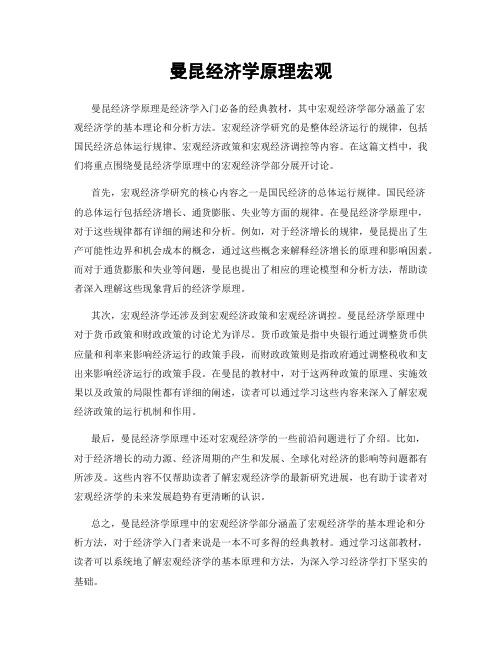
曼昆经济学原理宏观曼昆经济学原理是经济学入门必备的经典教材,其中宏观经济学部分涵盖了宏观经济学的基本理论和分析方法。
宏观经济学研究的是整体经济运行的规律,包括国民经济总体运行规律、宏观经济政策和宏观经济调控等内容。
在这篇文档中,我们将重点围绕曼昆经济学原理中的宏观经济学部分展开讨论。
首先,宏观经济学研究的核心内容之一是国民经济的总体运行规律。
国民经济的总体运行包括经济增长、通货膨胀、失业等方面的规律。
在曼昆经济学原理中,对于这些规律都有详细的阐述和分析。
例如,对于经济增长的规律,曼昆提出了生产可能性边界和机会成本的概念,通过这些概念来解释经济增长的原理和影响因素。
而对于通货膨胀和失业等问题,曼昆也提出了相应的理论模型和分析方法,帮助读者深入理解这些现象背后的经济学原理。
其次,宏观经济学还涉及到宏观经济政策和宏观经济调控。
曼昆经济学原理中对于货币政策和财政政策的讨论尤为详尽。
货币政策是指中央银行通过调整货币供应量和利率来影响经济运行的政策手段,而财政政策则是指政府通过调整税收和支出来影响经济运行的政策手段。
在曼昆的教材中,对于这两种政策的原理、实施效果以及政策的局限性都有详细的阐述,读者可以通过学习这些内容来深入了解宏观经济政策的运行机制和作用。
最后,曼昆经济学原理中还对宏观经济学的一些前沿问题进行了介绍。
比如,对于经济增长的动力源、经济周期的产生和发展、全球化对经济的影响等问题都有所涉及。
这些内容不仅帮助读者了解宏观经济学的最新研究进展,也有助于读者对宏观经济学的未来发展趋势有更清晰的认识。
总之,曼昆经济学原理中的宏观经济学部分涵盖了宏观经济学的基本理论和分析方法,对于经济学入门者来说是一本不可多得的经典教材。
通过学习这部教材,读者可以系统地了解宏观经济学的基本原理和方法,为深入学习经济学打下坚实的基础。
(完整版)曼昆宏观经济学原理答案
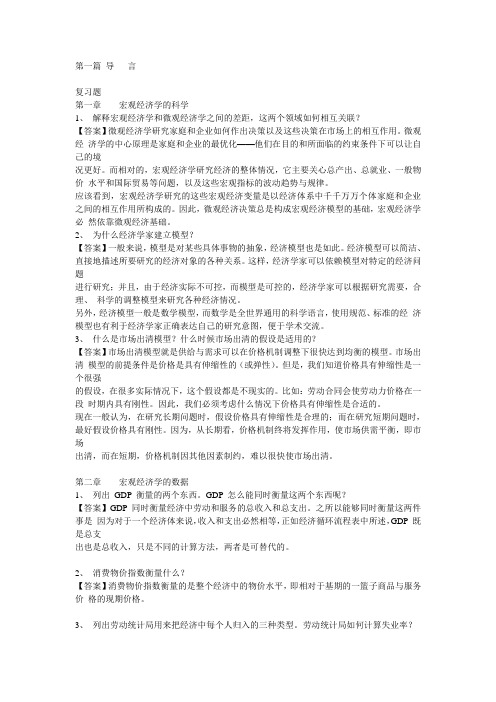
第一篇导言复习题第一章宏观经济学的科学1、解释宏观经济学和微观经济学之间的差距,这两个领域如何相互关联?【答案】微观经济学研究家庭和企业如何作出决策以及这些决策在市场上的相互作用。
微观经济学的中心原理是家庭和企业的最优化——他们在目的和所面临的约束条件下可以让自己的境况更好。
而相对的,宏观经济学研究经济的整体情况,它主要关心总产出、总就业、一般物价水平和国际贸易等问题,以及这些宏观指标的波动趋势与规律。
应该看到,宏观经济学研究的这些宏观经济变量是以经济体系中千千万万个体家庭和企业之间的相互作用所构成的。
因此,微观经济决策总是构成宏观经济模型的基础,宏观经济学必然依靠微观经济基础。
2、为什么经济学家建立模型?【答案】一般来说,模型是对某些具体事物的抽象,经济模型也是如此。
经济模型可以简洁、直接地描述所要研究的经济对象的各种关系。
这样,经济学家可以依赖模型对特定的经济问题进行研究;并且,由于经济实际不可控,而模型是可控的,经济学家可以根据研究需要,合理、科学的调整模型来研究各种经济情况。
另外,经济模型一般是数学模型,而数学是全世界通用的科学语言,使用规范、标准的经济模型也有利于经济学家正确表达自己的研究意图,便于学术交流。
3、什么是市场出清模型?什么时候市场出清的假设是适用的?【答案】市场出清模型就是供给与需求可以在价格机制调整下很快达到均衡的模型。
市场出清模型的前提条件是价格是具有伸缩性的(或弹性)。
但是,我们知道价格具有伸缩性是一个很强的假设,在很多实际情况下,这个假设都是不现实的。
比如:劳动合同会使劳动力价格在一段时期内具有刚性。
因此,我们必须考虑什么情况下价格具有伸缩性是合适的。
现在一般认为,在研究长期问题时,假设价格具有伸缩性是合理的;而在研究短期问题时,最好假设价格具有刚性。
因为,从长期看,价格机制终将发挥作用,使市场供需平衡,即市场出清,而在短期,价格机制因其他因素制约,难以很快使市场出清。
(2024年)曼昆《宏观经济学》完整版

2024/3/26
3
宏观经济学定义与研究对象
宏观经济学定义
宏观经济学是研究整个经济体系的总 体经济行为、经济表现、经济波动以 及经济政策对整体经济影响的学科。
研究对象
宏观经济学主要关注整个经济体系的 总体问题,如国民收入、就业、通货 膨胀、经济增长等。
2024/3/26
4
宏观经济学与微观经济学关系
净出口
出口减去进口的差额,受汇率、国际市场需求、贸易政策等 因素的影响。
17
总供给曲线形状及变动原因
• 总供给曲线形状:总供给曲线表示在一系列价格水平下,经济 社会愿意提供的总产量(或总收入)。在短期内,总供给曲线 可能呈现向右上方倾斜的形状,因为价格水平上升会刺激企业 增加生产;在长期内,总供给曲线可能呈现垂直形状,因为长 期内潜在产出水平是稳定的。
要点三
比较优势原理的应用
比较优势原理是现代国际贸易理论的 基础,它解释了为什么国际贸易会发 生以及贸易对各国经济的影响。各国 通过专业化生产和贸易,可以实现资 源的优化配置和经济效益的提高。
2024/3/26
22
汇率制度类型及特点比较
固定汇率制度
浮动汇率制度
固定汇率制度是指一国货币与另一国 货币或一篮子货币保持固定比价的汇 率制度。其特点包括汇率稳定、政策 纪律性强、有利于国际贸易和投资等 。但固定汇率制度也可Байду номын сангаас导致汇率失 真、国际收支失衡等问题。
2024/3/26
23
国际收支平衡表解读
国际收支平衡表的概 念
国际收支平衡表是一国在一定时期内 (通常为一年)与外国进行经济往来 的全部记录的统计表。它反映了一国 在一定时期内对外经济往来的总体情 况,包括贸易、服务、投资、援助等 方面的交易。
曼昆经济学原理 宏观

曼昆经济学原理宏观
曼昆经济学原理是经济学领域的经典教材之一,涵盖了微观经济学和宏观经济学的基本原理。
其中,宏观经济学的内容主要关注整体经济活动,例如国民收入、就业、通货膨胀等。
在宏观经济学中,曼昆提出了一系列重要的原理,如总需求等于总产出、货币供应量的影响、经济增长的驱动力等。
这些原理帮助我们更好地理解和分析经济体的运行状况,并提供了一些建议来改善经济状况。
总需求等于总产出的原理指出,一个经济体的总产出取决于总需求的水平。
当总需求增加时,企业会增加产量以满足需求,从而带动就业和经济增长。
反之,如果总需求下降,企业可能减少产量和就业。
货币供应量的影响原理指出,货币供应量的增加会导致物价上涨,也就是通货膨胀。
高通胀可能会降低人们的购买力,并导致经济不稳定。
因此,监管机构需要控制货币供应量,以维持经济的稳定。
经济增长的驱动力原理强调,长期经济增长是由劳动力增长、资本投资和技术革新所驱动的。
劳动力增长可以通过教育和培训来提升劳动者的技能水平。
资本投资包括企业和政府对新设备、基础设施等的投资。
技术革新则提高了生产力和效率,促进了经济增长。
总之,曼昆经济学原理中的宏观经济学部分提供了关于整体经
济运行的重要原理,从总需求与总产出的关系到货币供应量的影响,再到经济增长的驱动力。
这些原理帮助我们更好地理解宏观经济活动,并为制定经济政策提供了基础。
曼昆(经济学原理)第五版宏观经济学27

基本金融工具
7
主动学习 1
现值
你正在考虑以7万美元买一块6亩的土地,这块地在 5年后会值10万美元
A. 如果 r = 0.05,你是否应该买? B. 如果 r = 0.10,你是否应该买?
8
主动学习 1
参考答案
你正在考虑以7万美元买一块6亩的土地,这块地在 5年后会值10万美元 A. 如果 r = 0.05,你是否应该买?
保险允许风险分摊,能使风险厌恶的人更好: 比如,对于房子着火的风险,一万个人承担万分 之一的风险比你自己一个人独自承担全部风险容 易得多
基本金融工具
15
保险市场的两个问题
1. 逆向选择: 高风险的人从保险的保护中获益更大,所以高风 险的人比低风险的人更可能申请保险
2. 道德风险: 人们在购买保险之后,对他们谨慎从事以避免风 险的激励小了
未来货币量的现值:用现行利率产生一定量未来货 币所需要的现在货币量
相关概念: 货币量的未来值:在现行利率既定时,现在货币 量将带来的未来货币量
基本金融工具
3
例 1: 一个简单的存款
以5%的利率在银行存款$100,这笔钱的未来值是多 少?
N 年以后, FV = $100(1 + 0.05)N
3年以后, FV = $100(1 + 0.05)3 = $115.76
由于复利,利率的微小差别在长期会产生巨大的差 别
例如:买$1000微软的股票,并持有30年 如果回报率 = 0.08, FV = $10,063 如果回报率 = 0.10, FV = $17,450
基本金融工具
10
70规则
70规则: 如果一个变量每年按x%增长,那么大约在70/x年 以后,该变量翻一番
(2024年)曼昆经济学原理第五版宏观全ppt课件

03
货币市场与利率决定
2024/3/26
12
货币市场概述及工具
01
货币市场定义
货币市场是短期资金供求的场所, 主要交易一年以内的短期金融工
具。
2024/3/26
02
货币市场工具
03
货币市场功能
包括商业票据、银行承兑汇票、 大额可转让定期存单、回购协议
等。
提供短期资金融通、管理流动性、 发现短期资金价格等。
总供给
总供给减少会导致价格水平上升。
预期
预期通货膨胀率上升会导致价格水平上升。
2024/3/26
19
价格水平决定因素及模型
货币数量论
MV=PY,其中M为货币供应量,V为货币流 通速度,P为价格水平,Y为实际产出。该模 型认为价格水平由货币供应量和实际产出决 定。
2024/3/26
总供给-总需求模型
2024/3/26
27
国际金融理论与政策实践
国际金融理论
包括汇率决定理论、国际收支理论等,解释国 际金融市场的运行和汇率波动的原因。
2024/3/26
国际金融政策工具
包括汇率政策、国际储备政策、国际金融机构等,分 析其对国际金融稳定和发展的作用。
国际金融危机与应对
探讨国际金融危机的成因、传导机制和应对措 施,以及国际合作在危机应对中的重要性。
结构类型
根据劳动力供求双方的特点和交易方式,劳动市场可分为完 全竞争市场、买方垄断市场、卖方垄断市场和双边垄断市场 四种类型。
2024/3/26
23
工资水平决定因素及模型
决定因素
工资水平受多种因素影响,包括劳动力供求关系、劳动生 产率、经济发展水平、行业差异、地区差异等。
曼昆经济学原理宏观经济学分册
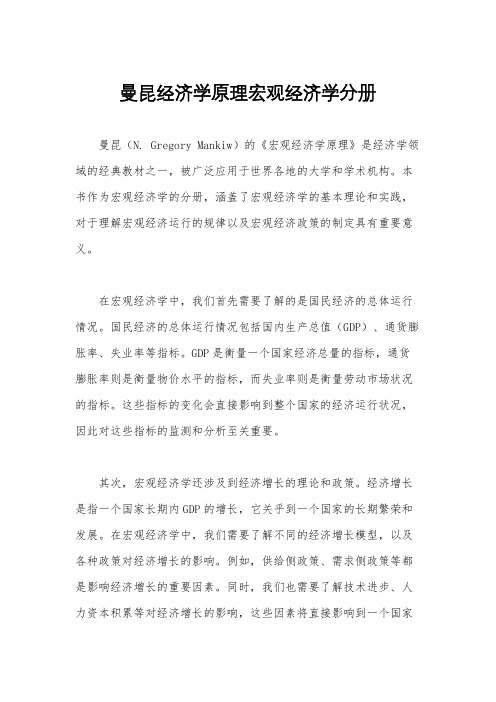
曼昆经济学原理宏观经济学分册曼昆(N. Gregory Mankiw)的《宏观经济学原理》是经济学领域的经典教材之一,被广泛应用于世界各地的大学和学术机构。
本书作为宏观经济学的分册,涵盖了宏观经济学的基本理论和实践,对于理解宏观经济运行的规律以及宏观经济政策的制定具有重要意义。
在宏观经济学中,我们首先需要了解的是国民经济的总体运行情况。
国民经济的总体运行情况包括国内生产总值(GDP)、通货膨胀率、失业率等指标。
GDP是衡量一个国家经济总量的指标,通货膨胀率则是衡量物价水平的指标,而失业率则是衡量劳动市场状况的指标。
这些指标的变化会直接影响到整个国家的经济运行状况,因此对这些指标的监测和分析至关重要。
其次,宏观经济学还涉及到经济增长的理论和政策。
经济增长是指一个国家长期内GDP的增长,它关乎到一个国家的长期繁荣和发展。
在宏观经济学中,我们需要了解不同的经济增长模型,以及各种政策对经济增长的影响。
例如,供给侧政策、需求侧政策等都是影响经济增长的重要因素。
同时,我们也需要了解技术进步、人力资本积累等对经济增长的影响,这些因素将直接影响到一个国家的长期经济发展。
另外,宏观经济学还包括货币政策和财政政策的研究。
货币政策是指中央银行通过调整货币供应量和利率来影响经济的政策,而财政政策则是指政府通过调整税收和支出来影响经济的政策。
这两种政策对于调控经济增长、控制通货膨胀、促进就业等方面都具有重要作用。
在宏观经济学中,我们需要了解这两种政策的理论基础,以及它们在实践中的应用和效果。
最后,宏观经济学还涉及国际经济关系和国际贸易。
国际经济关系包括汇率、国际收支、国际金融等方面,而国际贸易则涉及到不同国家之间的商品和服务交换。
在全球化的今天,国际经济关系和国际贸易对于每个国家的经济发展都具有重要意义,因此我们需要了解国际经济关系和国际贸易的基本理论和实践。
总之,曼昆的《宏观经济学原理》作为宏观经济学的经典教材,涵盖了宏观经济学的基本理论和实践,对于理解宏观经济运行的规律以及宏观经济政策的制定具有重要意义。
曼昆经济学原理宏观

曼昆经济学原理宏观曼昆的《经济学原理》是经济学入门的经典教材,其中的宏观经济学部分涵盖了宏观经济学的基本原理和理论。
宏观经济学是研究整体经济运行规律的学科,通过对国民经济总体现象的分析,揭示了经济运行的一般规律和宏观经济政策的基本原理。
在这篇文档中,我们将围绕曼昆经济学原理宏观这一主题,简要介绍宏观经济学的基本内容和重要原理。
首先,我们需要了解宏观经济学研究的对象。
宏观经济学主要研究整个国民经济的总体运行状况和发展趋势,包括国民收入、总产出、总就业、通货膨胀、经济增长等方面。
通过对这些总体经济现象的研究,可以更好地把握经济的发展方向,制定宏观经济政策,促进经济的健康发展。
其次,我们需要了解宏观经济学的核心理论。
曼昆在书中系统地阐述了宏观经济学的核心理论,包括总需求与总供给、通货膨胀与失业之间的关系、货币政策与财政政策的作用等。
这些理论为我们理解宏观经济运行提供了重要的理论基础,也为我们分析宏观经济政策的效果提供了依据。
再者,我们需要了解宏观经济政策的基本原则。
宏观经济政策是指国家为了实现宏观经济目标而采取的政策手段,包括货币政策和财政政策。
曼昆详细介绍了这两种政策的原理和作用,以及它们在实践中的应用。
了解这些原则可以帮助我们更好地理解国家宏观经济政策的制定和调控过程。
最后,我们需要了解宏观经济学的发展趋势。
随着全球化和信息技术的发展,宏观经济学也在不断发展和完善。
新的经济现象和问题不断涌现,需要我们不断深化对宏观经济学的理解和研究。
同时,宏观经济政策也需要不断调整和改进,以适应新的经济形势和挑战。
总之,曼昆的《经济学原理》中的宏观经济学部分涵盖了丰富的内容,对于我们理解宏观经济学的基本原理和理论具有重要的指导意义。
通过学习和掌握这些内容,我们可以更好地理解国民经济的运行规律,为经济决策和实践提供理论支持。
希望本文可以帮助大家更好地理解曼昆经济学原理宏观这一重要内容,也希望大家能够在实践中不断深化对宏观经济学的理解和应用。
(微观 宏观全)曼昆《经济学原理》(第五版)课后习题答案-中文版

曼昆《经济学原理》(第五版)习题解答目录第一章经济学十大原理 (1)第二章像经济学家一样思考 (7)第三章相互依存性与贸易的好处 (14)第四章供给与需求的市场力量 (22)第五章弹性及其应用 (31)第六章供给、需求与政府政策 (41)第七章消费者、生产者与市场效率 (50)第八章应用:赋税的代价 (58)第九章应用:国际贸易 (65)第十章外部性 (75)第十一章公共物品和公共资源 (84)第十二章税制的设计 (91)第十三章生产成本 (99)第十四章竞争市场上的企业 (109)第十五章垄断 (121)第十六章垄断竞争 (135)第十七章寡头 (143)第十八章生产要素市场 (153)第十九章收入与歧视 (162)第二十章收入不平等与贫困 (169)第二十一章消费者选择理论 (177)第二十二章微观经济学前沿 (187)第二十三章一国收入的衡量 (195)第二十四章生活费用的衡量 (204)第二十五章生产与增长 (210)第二十六章储蓄、投资和金融体系 (214)第二十七章基本金融工具 (221)第二十八章失业 (226)第一篇导言第一章经济学十大原理复习题1.列举三个你在生活中面临的重要权衡取舍的例子。
答:①大学毕业后,面临着是否继续深造的选择,选择继续上学攻读研究生学位,就意味着在今后三年中放弃参加工作、赚工资和积累社会经验的机会;②在学习内容上也面临着很重要的权衡取舍,如果学习《经济学》,就要减少学习英语或其他专业课的时间;③对于不多的生活费的分配同样面临权衡取舍,要多买书,就要减少在吃饭、买衣服等其他方面的开支。
2.看一场电影的机会成本是什么?答:看一场电影的机会成本是在看电影的时间里做其他事情所能获得的最大收益,例如:看书、打零工。
3.水是生活必需的。
一杯水的边际利益是大还是小呢?答:这要看这杯水是在什么样的情况下喝,如果这是一个人五分钟内喝下的第五杯水,那么他的边际利益很小,有可能为负;如果这是一个极度干渴的人喝下的第一杯水,那么他的边际利益将会极大。
- 1、下载文档前请自行甄别文档内容的完整性,平台不提供额外的编辑、内容补充、找答案等附加服务。
- 2、"仅部分预览"的文档,不可在线预览部分如存在完整性等问题,可反馈申请退款(可完整预览的文档不适用该条件!)。
- 3、如文档侵犯您的权益,请联系客服反馈,我们会尽快为您处理(人工客服工作时间:9:00-18:30)。
14.1 货币政策与财政政策决策者应 该试图稳定经济吗 14.2 货币政策应该按规则制定还是 相机抉择 14.3 中央银行应该把零通货膨胀作 为目标吗 14.4 政府应该平衡其预算吗 14.5 应该为了鼓励储蓄而修改税法 吗
▪ 固定的货币增长率 ▪ 通货膨胀目标:
▪ 如果实际通货膨胀低于目标通货膨胀,联储
增加货币供给
▪ 如果实际通货膨胀高于目标通货膨胀,联储
减少货币供给
整理ppt
9
2.货币政策应该按规则制定还是相机抉择
货币政策不应该相机抉择:
▪ 如果中央银行领导人缺乏能力,允许他们相机抉择
会对经济造成巨大的损害
▪ 相机抉择含有滥用权力的可能性 ▪ 例如:中央银行领导人使用货币政策来影响选举
整理ppt
5
主动学习 1
积极稳定经济的政策
当工资,物价水平和预期对经济状况的变动反应很 快时,你会支持积极稳定的政策吗?如果反应很慢, 你仍会支持积极稳定的政策吗?
6
主动学习 1
参考答案
如果工资,物价水平和预期调整缓慢,经济需要更 多时间才能回到自然产量率与自然失业率 在这种情况下,扩张性政策能及时减缓经济的衰退 程度,而不是把经济推向通胀性繁荣
17
主动学习 2
参考答案
B. 如果要降低3%的实际工资,通货膨胀率是0%还 是4%时会更容易?为什么? 为维持零通货膨胀条件下的劳动市场均衡,行 政管理人员需要接受名义工资下降3% 在4%通货膨胀条件下,他们只需要接受名义工 资增长1% 第二种情形更可行,因为很多人会有“货币幻 觉”,只关注名义变量,而不是实际变量
1
14.1 货币政策与财政政策决策者应 该试图稳定经济吗 14.2 货币政策应该按规则制定还是 相机抉择 14.3 中央银行应该把零通货膨胀作 为目标吗 14.4 政府应该平衡其预算吗 14.5 应该为了鼓励储蓄而修改税法 吗
整理ppt
2
介绍
▪ 本课程介绍了经济学家用来分析整体经济行为和
政策对经济影响的工具
36 C H A P T E R
经济学原理
N. 格里高利·曼昆
宏观经济政策的五个
争论问题
本章我们将探索这些问题的答案:
关于下列问题,争论的双方分别持什么观点?
▪ 决策者应该稳定经济吗? ▪ 货币政策应该按规则制定还是相机抉择吗? ▪ 中央银行应该把零通货膨胀作为目标吗? ▪ 政府应该平衡其预算吗? ▪ 应该为了鼓励储蓄而修改税法吗?
结果,引起的经济波动称为 “政治性经济周期”
▪ 当经济发生衰退时,承诺物价水平稳定的中央银行
领导人可能会背信:
▪ 政策的前后不一致性:实际政策与已宣布政策之
间的不同
整理ppt
10
2.货币政策应该按规则制定还是相机抉择
支持相机抉择:
▪ 相机抉择允许联储灵活应对未预测到的事件 ▪ 政治性经济周期和政策的前后不一致性只是理论
上的可能性,其在实践中并不重要
▪ 详细说明准确的规则和确定什么是最好的规则是
非常困难的
整理ppt
11
14.1 货币政策与财政政策决策者应 该试图稳定经济吗 14.2 货币政策应该按规则制定还是 相机抉择 14.3 中央银行应该把零通货膨胀作 为目标吗 14.4 政府应该平衡其预算吗 14.5 应该为了鼓励储蓄而修改税法 吗
▪ 与温和通货膨胀相比,零通货膨胀的好处并不大,
然而实现零通货膨胀的成本是很大的
▪ 估算:减少1%的通货膨胀要求放弃一年 GDP的
5%
▪ 反通货膨胀所引பைடு நூலகம்的衰退在经济中会潜在留下持
久性的印记:
▪ 投资减少,未来资本存量也减少 ▪ 当工人们在衰退成为失业者时,他们失去了
有价值的工作技能
▪ 可以通过指数化来减少通货膨胀的一些成本
▪ 每个人都能从一个更加稳定的经济中受益
整理ppt
4
1.决策者应该试图稳定经济吗?
积极稳定政策的批评者:
▪ 货币政策与财政政策发生作用有一个相当长的时滞,
因此政策必须在经济状况改变之前执行
▪ 但引起经济波动的冲击是无法预测的,而且对未来
经济状况的预测是极不准确的
▪ 如果政策发生作用太迟,它可能会加剧波动 ▪ 因此,经济应该靠自己的能力进行自我恢复
▪ 即使是温和的通货膨胀,通货膨胀的成本(皮鞋
成本,菜单成本等)也很大
▪ 实现零通货膨胀会有暂时有成本(更高的失业),
但却长期有好处
▪ 如果零通货膨胀的承诺是可信的,这便会降低
人们的通货膨胀预期,实现零通货膨胀的成本 也会降低
整理ppt
14
3.中央银行应该把零通货膨胀作为目标吗?
反对零通货膨胀目标:
7
14.1 货币政策与财政政策决策者应 该试图稳定经济吗 14.2 货币政策应该按规则制定还是 相机抉择 14.3 中央银行应该把零通货膨胀作 为目标吗 14.4 政府应该平衡其预算吗 14.5 应该为了鼓励储蓄而修改税法 吗
整理ppt
8
2. 货币政策应该按规则制定还是相机抉择
▪ 美联储几乎完全采用相机抉择的货币政策 ▪ 一些人认为美联储应该遵循一个规则,比如:
整理ppt
12
3.中央银行应该把零通货膨胀作为目标吗?
▪ 第一章中的经济学十大原理:
当政府发行了过多货币时,物价上升 社会面临通货膨胀与失业之间的短期权衡取舍
▪ 中央银行愿意忍受的通货膨胀应该是多少?零通
货膨胀是适当的目标吗?
整理ppt
13
3.中央银行应该把零通货膨胀作为目标吗?
支持零通货膨胀目标:
▪ 这最后一章讨论五个宏观经济政策的经典问题
整理ppt
3
1. 决策者应该试图稳定经济吗?
积极稳定政策的支持者:
▪ 如果放任不管,经济就倾向于发生波动
例如:当家庭与企业变得悲观时,他们就削减支 出,这就减少了物品与劳务的总需求,引起经济 衰退
▪ 决策者能“逆风向行事”—使用货币政策与财政
政策来稳定总需求,产出与就业
整理ppt
15
主动学习 2
零通货膨胀率
如果一种结构性改变减少了对大学行政管理人员的 需求,使他们的均衡工资减少了3% A. 如果支付给大学行政管理员的实际的真实工资保
持不变,这会出现什么结果? B. 如果要降低3%的实际工资,通货膨胀率是0%还
是4%时会更容易?为什么?
16
主动学习 2
参考答案
A. 如果支付给大学行政管理员的实际的真实工资保 持不变,这会出现什么结果? 当实际的真实工资超过均衡的实际工资时,会存 在劳动力过剩,这代表资源的浪费 当工资降低时,这会鼓励一些行政管理员转向大 学的教学岗位或私人部门
